Performance Study on Laterite Road Base Stabilised with Emulsions Incorporating Biochar
Abstract
:1. Introduction
2. Materials and Methodology
2.1. Aggregate
2.2. Emulsion
2.3. Biochar
2.4. Mixing
2.5. Sample Preparations and Lab Testing
2.6. Field Trials
3. Results and Discussions
3.1. Unconfined Compressive Strength
3.2. Indirect Tensile Strength
3.3. Resilient Modulus—Indirect Tensile Method
3.4. Four-Point Beam Bending Tests
3.4.1. Flexural Modulus
3.4.2. Fatigue
3.5. Wheel Tracking
4. Field Trials
4.1. Watheroo
4.2. Kwinana Grain Terminal
5. Conclusions
- The unconfined compressive strength (UCS) tests demonstrated that the biochar–emulsion binder significantly augmented the strength of road base materials, with the optimal content being 5% biochar. However, an increase beyond this percentage led to a decrease in strength, attributable to the physical properties of biochar.
- The indirect tensile strength (ITS) results suggested that both emulsion and biochar content significantly affect the strength of road base materials. The optimal dry ITS value was achieved with a mixture composed of 5% biochar and 8% emulsion, while the maximum soaked ITS value was reached with a mixture comprising 3% biochar and 8% emulsion.
- A review of the resilient modulus outcomes revealed that a biochar-to-emulsion ratio of 1:1.6 yields the highest resilient modulus for the material in dry conditions. Conversely, in wet conditions, a biochar-to-emulsion ratio of 1:1.4 demonstrated the highest resilient modulus.
- The flexural modulus tests indicated that material stiffness decreases as temperature rises, while an increase in frequency has less of an impact. Furthermore, fatigue testing suggested that the flexural modulus decreases gradually with an increase in cyclic loading.
- Wheel-tracking tests showed that emulsion–biochar-treated samples have good deformation performance and high fatigue resistance, with the final rutting depth being significantly lower than the recommended maximum.
- Field trials carried out in Watheroo and Kwinana Grain Terminal exemplify the practical effectiveness of using biochar and emulsion in pavement rehabilitation. The treated pavements exhibited enhanced stiffness and structural adequacy, with minor surface defects observed.
Author Contributions
Funding
Data Availability Statement
Acknowledgments
Conflicts of Interest
References
- Tayibi, H.; Choura, M.; López, F.A.; Alguacil, F.J.; López-Delgado, A. Environmental impact and management of phosphogypsum. J. Environ. Manag. 2009, 90, 2377–2386. [Google Scholar] [CrossRef] [PubMed]
- Md Zahri, A.; Zainorabidin, A. An overview of traditional and non-traditional stabilizers for soft soil. IOP Conf. Ser. Mater. Sci. Eng. 2019, 527, 012015. [Google Scholar] [CrossRef]
- Tingle, J.S.; Santoni, R.L. Stabilization of clay soils with nontraditional additives. Transp. Res. Rec. 2003, 1819, 72–84. [Google Scholar] [CrossRef]
- Tan, E.; Zahran, E.; Tan, S. A review of chemical stabilisation in road construction. In Proceedings of the IOP Conference Series: Materials Science and Engineering, Ufa, Russia, 5–9 October 2020; p. 012005. [Google Scholar]
- Muhammad, D. Biomaterial biochar for soil carbon sequestration strategy and its future prospects. In Proceedings of the IOP Conference Series: Earth and Environmental Science, Stuttgart, Germany, 9–11 October 2019; p. 012014. [Google Scholar]
- Yaro, N.S.A.; Sutanto, M.H.; Habib, N.Z.; Usman, A.; Kaura, J.M.; Murana, A.A.; Birniwa, A.H.; Jagaba, A.H. A comprehensive review of biochar utilization for low-carbon flexible asphalt pavements. Sustainability 2023, 15, 6729. [Google Scholar] [CrossRef]
- Sohi, S.; Lopez-Capel, E.; Krull, E.; Bol, R. Biochar, climate change and soil: A review to guide future research. CSIRO Land Water Sci. Rep. 2009, 5, 17–31. [Google Scholar]
- Gupta, S.; Kua, H.W.; Low, C.Y. Use of biochar as carbon sequestering additive in cement mortar. Cem. Concr. Compos. 2018, 87, 110–129. [Google Scholar] [CrossRef]
- Çeloğlu, M.E.; Mehmet, Y.; Kök, B.V.; Yalçin, E. Effects of various biochars on the high-temperature performance of bituminous binder. In Proceedings of the 6th Euraphalt & Eurobitume Congress, Prague, Czech Republic, 1–3 June 2016; pp. 1–3. [Google Scholar]
- Zhou, X.; Adhikari, S. Flow-induced crystallization of biochar in bio-asphalt under various ageing conditions. Sci. Total Environ. 2019, 695, 133943. [Google Scholar] [CrossRef] [PubMed]
- Zhao, S.; Huang, B.; Ye, P. Laboratory evaluation of asphalt cement and mixture modified by bio-char produced through fast pyrolysis. In Pavement Materials, Structures, and Performance; ASCE: Shanghai, China, 2014; pp. 140–149. [Google Scholar]
- Dong, W.; Ma, F.; Li, C.; Fu, Z.; Huang, Y.; Liu, J. Evaluation of anti-ageing performance of biochar modified asphalt binder. Coatings 2020, 10, 1037. [Google Scholar] [CrossRef]
- Gan, X.; Zhang, W. Application of biochar from crop straw in asphalt modification. PLoS ONE 2021, 16, e0247390. [Google Scholar] [CrossRef] [PubMed]
- Xiang, L.; Liu, S.; Ye, S.; Yang, H.; Song, B.; Qin, F.; Shen, M.; Tan, C.; Zeng, G.; Tan, X. Potential hazards of biochar: The negative environmental impacts of biochar applications. J. Hazard. Mater. 2021, 420, 126611. [Google Scholar] [CrossRef] [PubMed]
- Main Roads Western Australia. WA 115.2—Particle Size Distribution Abbreviated Method for Coarse and Medium-Grained Soils Test Method; Main Roads Western Australia: Perth, WA, Australia, 2019. [Google Scholar]
- AS 1289.3.1.1; Method 3.9.1: Soil Classification Tests-Determination of the Liquid Limit of a Soil. Standards Australia: Sydney, NSW, Australia, 2015; pp. 1–9.
- AS 1289.3.2.1; Method 3.2.1: Soil Classification Tests-Determination of the Plastic Limit of a Soil-Standard Method. Standards Australia: Sydney, NSW, Australia, 2009; pp. 1–5.
- Main Roads Western Australia. Specification 501—Pavements Design Guide; Main Roads Western Australia: Perth, WA, Australia, 2021. [Google Scholar]
- Main Roads Western Australia. WA 133.1—Dry Density/Moisture Content Relationship: Modified Compaction Fine and Medium-Grained Soils Test Method; Main Roads Western Australia: Perth, WA, Australia, 2020. [Google Scholar]
- Austroads. Guide to Pavement Technology—Part 2: Pavement Structural Design Guide; Austroads: Sydney, NSW, Australia, 2017. [Google Scholar]
- Main Roads Western Australia. WA 143.1—Determination of the Unconfined Compressive Strength of Laboratory Compacted Specimens Test Method; Main Roads Western Australia: Perth, WA, Australia, 2012. [Google Scholar]
- NZTA T-19 Specification. Procedures for Design and Indirect Tensile Strength Testing of Modified and Bound Pavement Materials; Waka Kotahi NZ Transport Agency: New Zealand Government: Wellington, New Zealand, 2020. [Google Scholar]
- AS 2891.13.1; Methods of Sampling and Testing Asphalt: Method 13.1: Determination of the Resilient Modulus of Asphalt—Indirect tensile method. Standards Australia: Sydney, NSW, Australia, 1995.
- AG: PT/T231; Deformation Resistance of Asphalt Mixtures by the Wheel Tracking Tests. Austroads: Sydney, NSW, Australia, 2006.
- AG: PT/T220; Sample Preparation—Compaction of Asphalt Slabs. Austroads: Sydney, NSW, Australia, 2005.
- Austroads. Guide to Pavement Technology Part 4D: Stabilised Materials; Austroads: Sydney, NSW, Australia, 2019. [Google Scholar]
- Carpenter, S. Perpetual pavement: Laboratory validation. In Proceedings of the 57th Annual Ohio Transportation Engineering Conference, Dublin, Ireland, 27–28 November 2003; Available online: https://otec.transportation.ohio.gov/presentations/OTECpresentations/Se20/Carpenter-OHIOFatigue.pdf (accessed on 22 January 2024).
- Liang, B.; Lan, F.; Shi, K.; Qian, G.; Liu, Z.; Zheng, J. Review on the self-healing of asphalt materials: Mechanism, affecting factors, assessments and improvements. Constr. Build. Mater. 2021, 266, 120453. [Google Scholar] [CrossRef]
- Austroads. Developed Design Procedures for Lightly Bound Cemented Materials in Flexible Pavements; Austroads: Sydney, NSW, Australia, 2020. [Google Scholar]
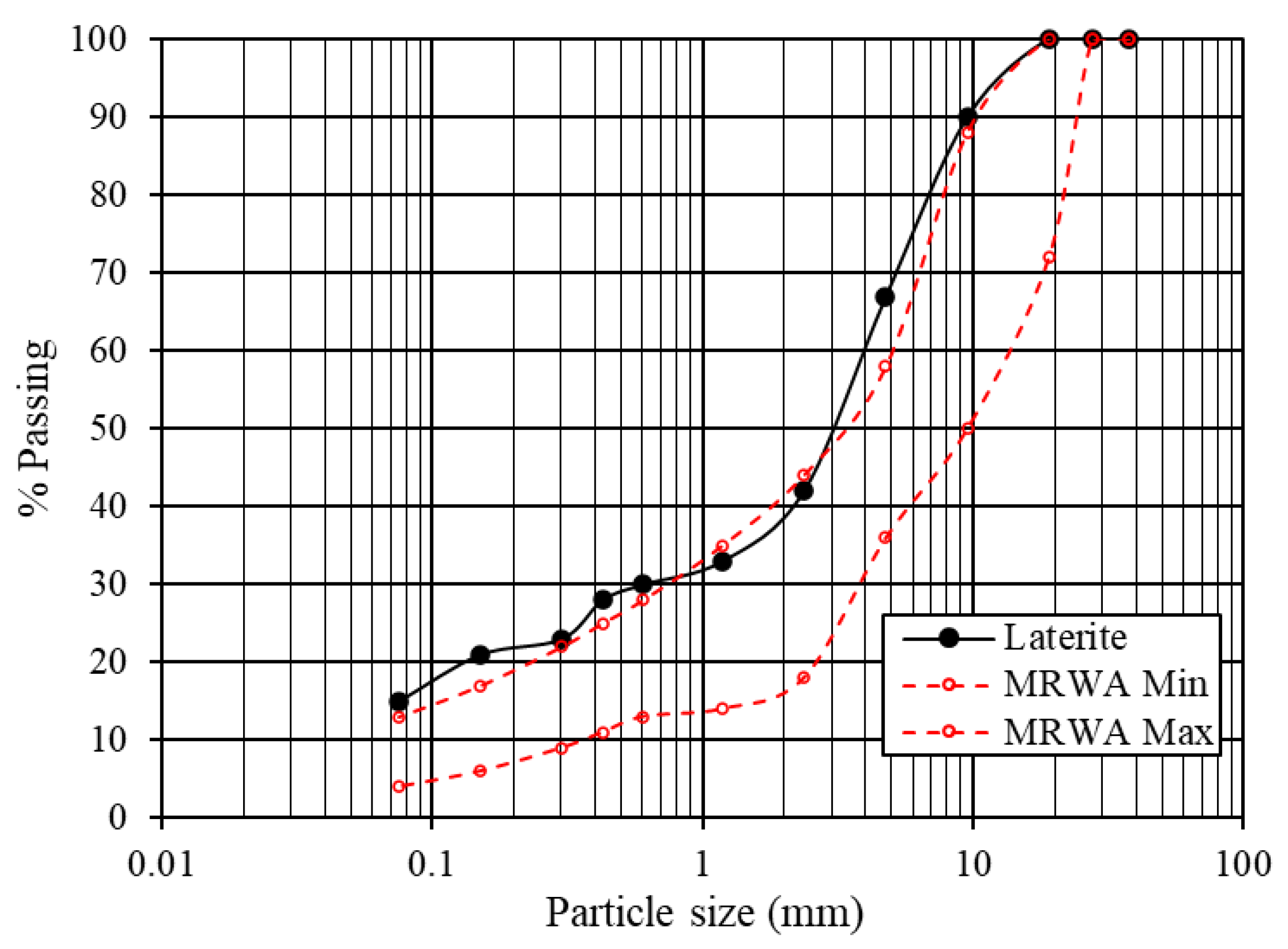
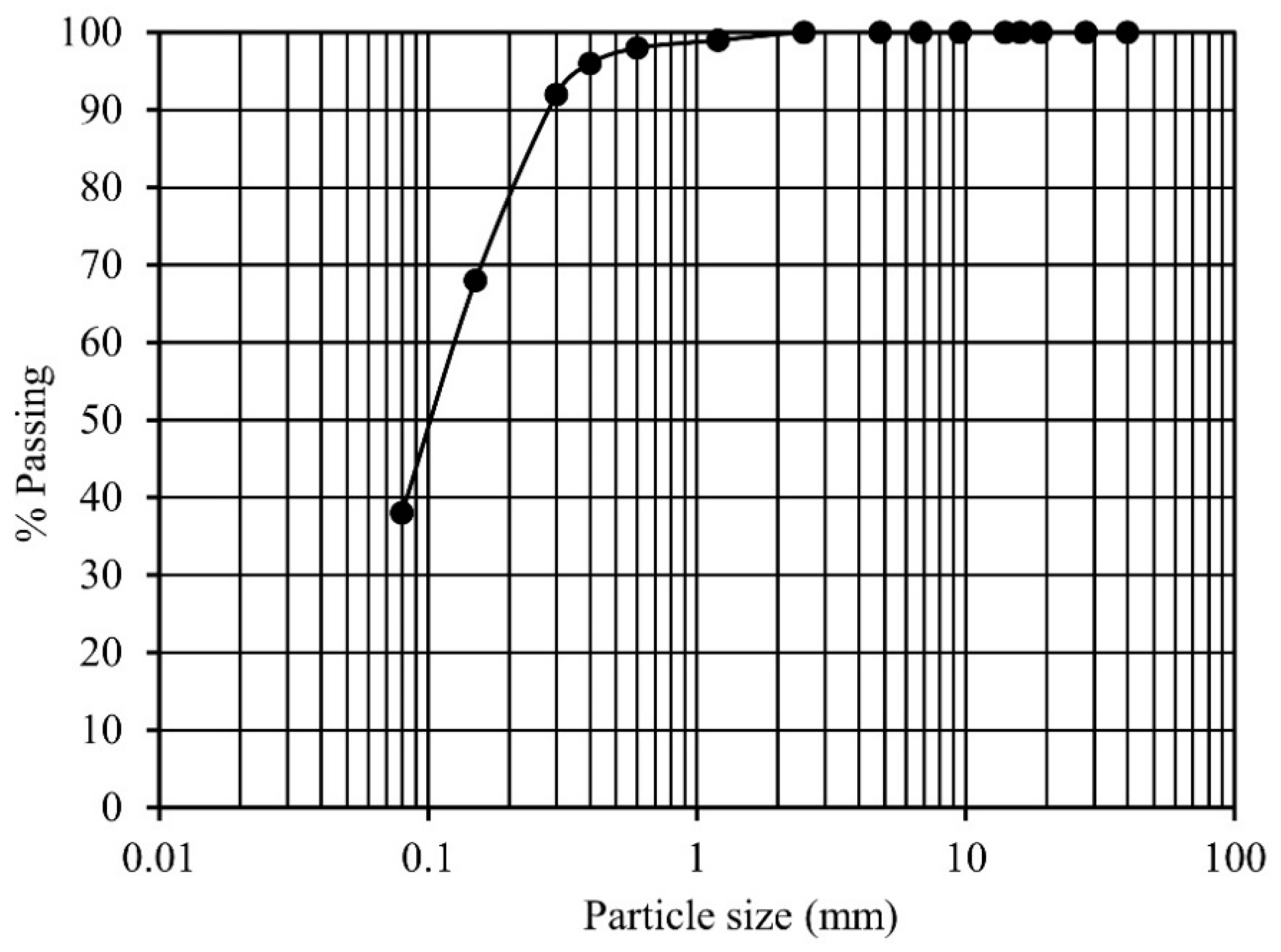
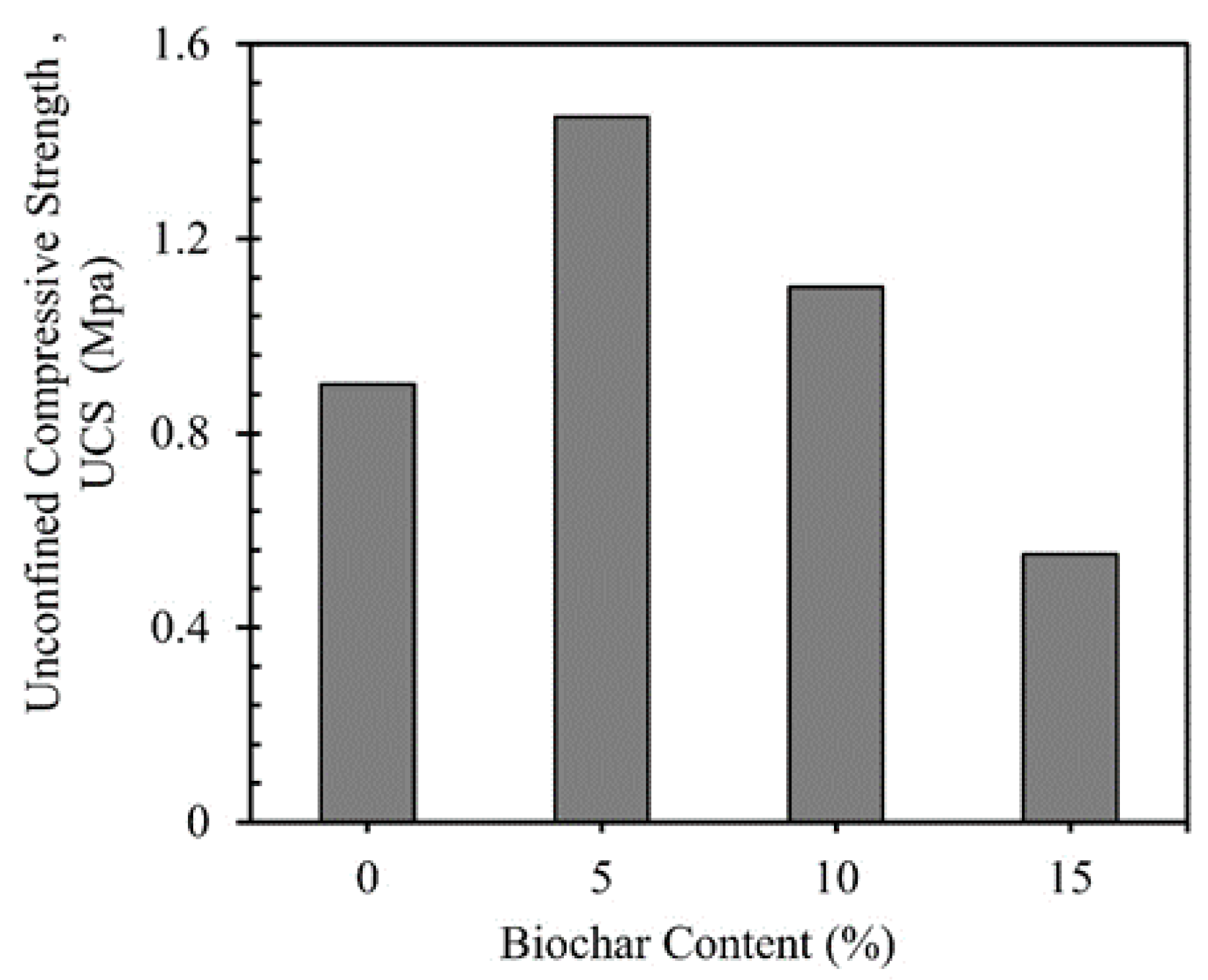
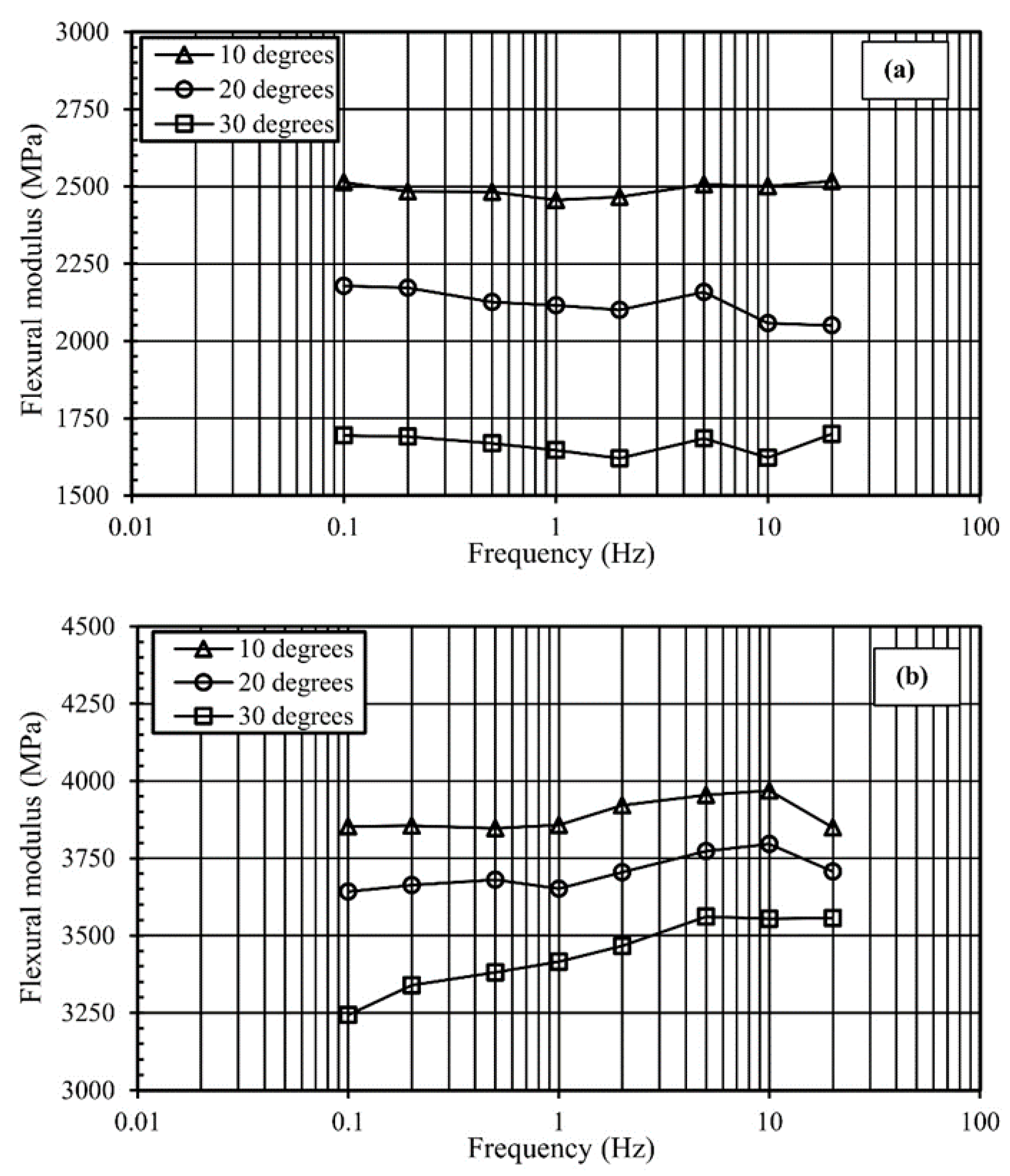
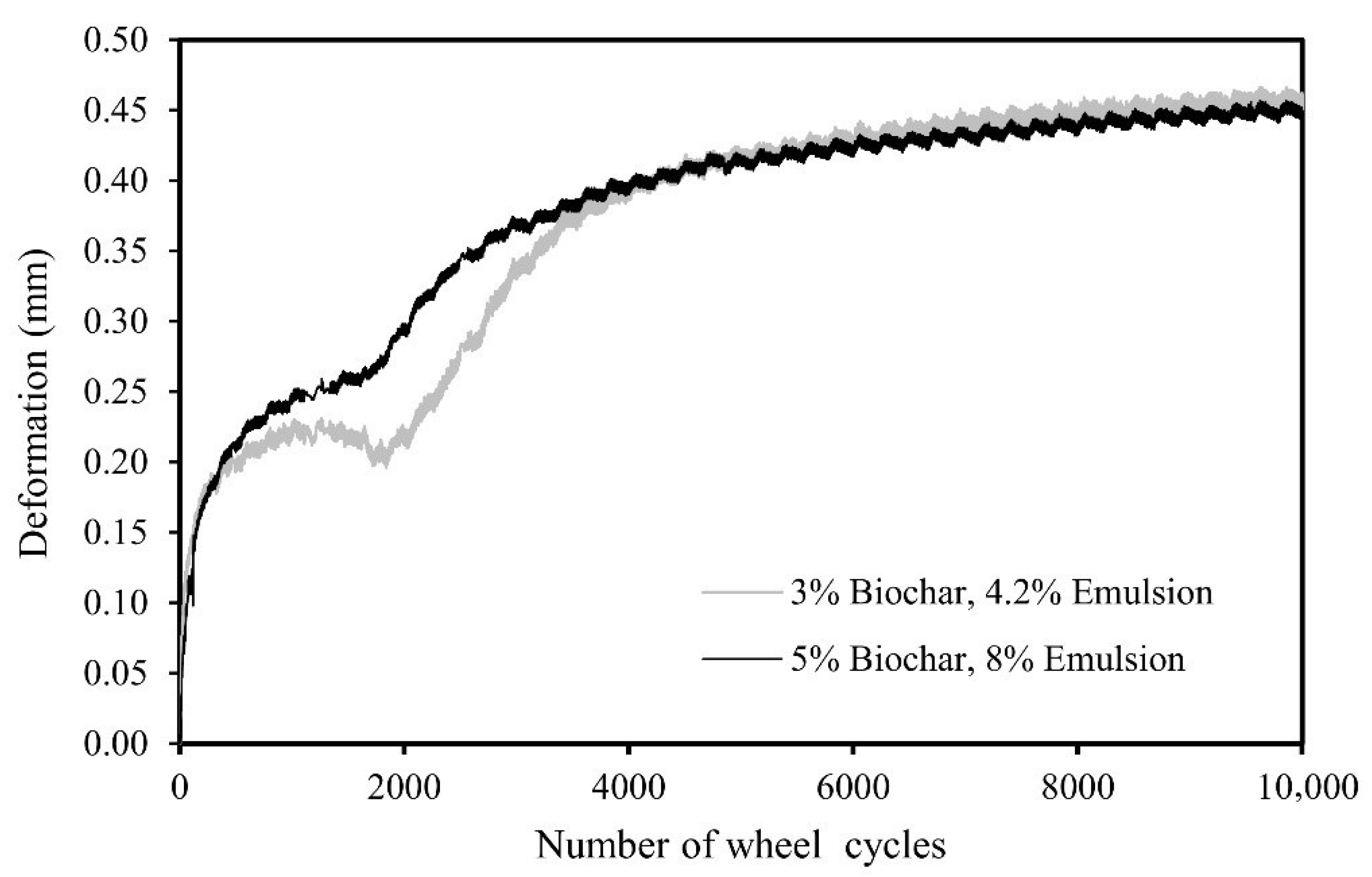


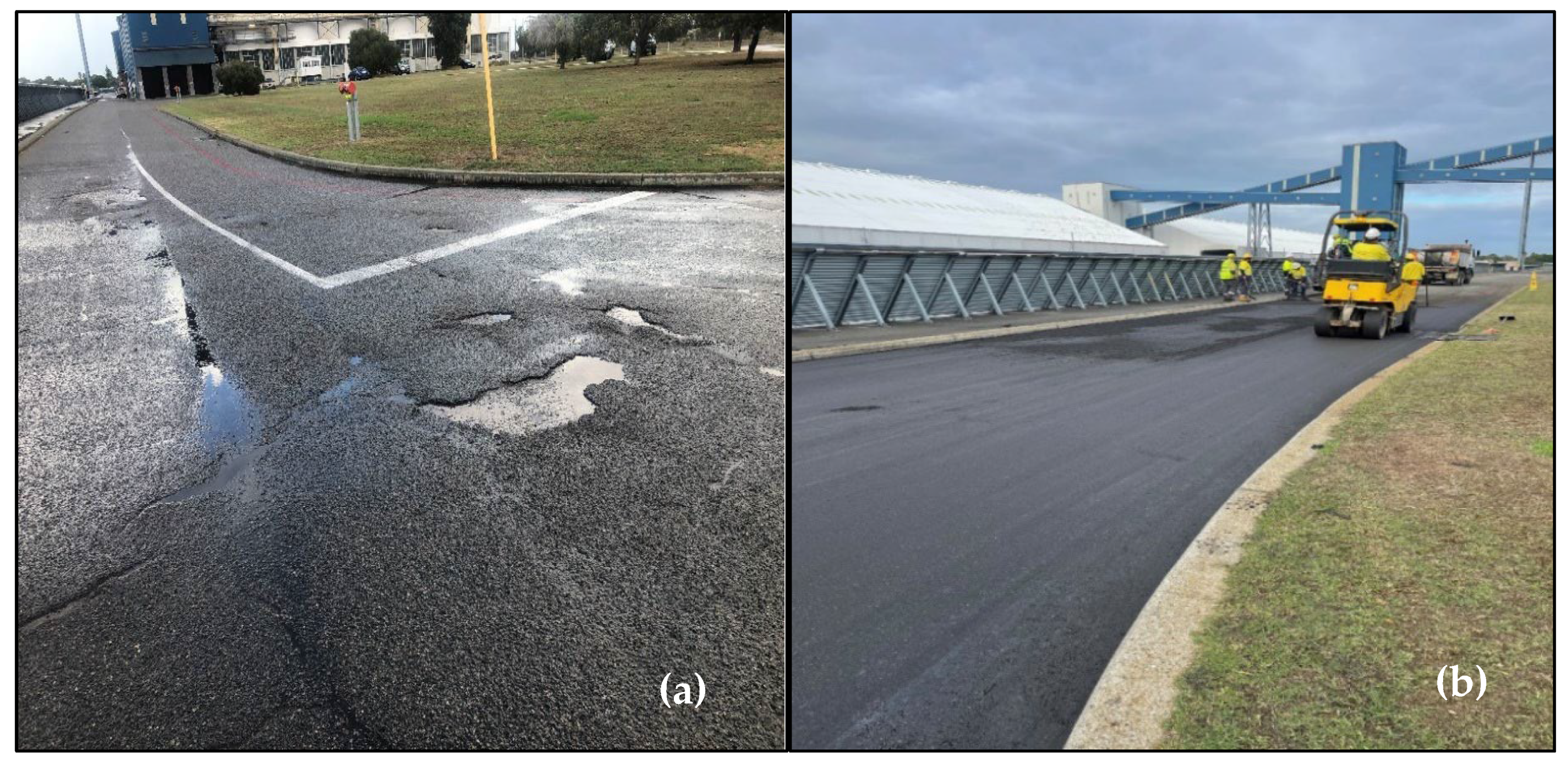
| Property | Value |
|---|---|
| Liquid Limit (LL) | 22% |
| Plastic Limit (PL) | 16% |
| Plasticity Index (PI) | 6% |
| Test | Emulsion (%) * | Biochar (%) * | Biochar: Emulsion |
|---|---|---|---|
| Unconfined compressive strength (UCS) | 6 | 5 | - |
| 10 | - | ||
| 15 | - | ||
| Indirect tensile strength (ITS) | 4 | 3 | - |
| 5 | - | ||
| 7 | - | ||
| 6 | 3 | - | |
| 5 | - | ||
| 7 | - | ||
| 8 | 3 | - | |
| 5 | - | ||
| 7 | - | ||
| Resilient modulus—indirect tensile method (ITM) | 3.6 | 3 | 1:1.2 |
| 5 | 1:1.4 | ||
| 7 | 1:1.6 | ||
| 4.2 | 3 | 1:1.8 | |
| 5 | 1:1.2 | ||
| 7 | 1:1.4 | ||
| 4.8 | 3 | 1:1.6 | |
| 5 | 1:1.8 | ||
| 7 | 1:1.2 | ||
| 5.4 | 3 | 1:1.4 | |
| 5 | 1:1.6 | ||
| 7 | 1:1.8 | ||
| Four-point beam (flexural modulus and fatigue tests) | Conducted on optimum mixture obtained from ITM testing | ||
| Wheel tracking | |||
| Emulsion (%) | Biochar (%) | Dry ITS (kPa) | Wet ITS (kPa) | ITS Ratio (Wet/Dey) |
|---|---|---|---|---|
| 4 | 3 | 241 | 228 | 0.95 |
| 5 | 287 | 230 | 0.80 | |
| 7 | 181 | 147 | 0.81 | |
| 6 | 3 | 286 | 277 | 0.97 |
| 5 | 301 | 259 | 0.86 | |
| 7 | 252 | 239 | 0.95 | |
| 8 | 3 | 371 | 391 | 1.05 |
| 5 | 406 | 365 | 0.90 | |
| 7 | 340 | 322 | 0.95 |
| Pavement Type | Dry ITS (kPa) | Soaked ITS (kPa) |
|---|---|---|
| Cement/lime modified base material | 150 to 350 | 100 to 300 |
| Foamed-bitumen-stabilised base material | 175 to 400 | 150 to 350 |
| Cement-bound subbase material | >500 | >450 |
| Biochar (%) | Emulsion (%) | Biochar-to-Emulsion Ratio | 3-Day Dry Resilient Modulus (MPa) | 3-Day Wet Resilient Modulus (MPa) |
|---|---|---|---|---|
| 3 | 3.6 | 1:1.2 | 5285 | 2062 |
| 4.2 | 1:1.4 | 5943 | 5265 | |
| 4.8 | 1:1.6 | 7007 | 4348 | |
| 5.4 | 1:1.8 | 6261 | 4468 | |
| 5 | 6 | 1:1.2 | 5124 | 2562 |
| 7 | 1:1.4 | 5149 | 4118 | |
| 8 | 1:1.6 | 5198 | 4661 | |
| 9 | 1:1.8 | 4914 | 4351 | |
| 7 | 8.4 | 1:1.2 | 4115 | 2352 |
| 9.8 | 1:1.4 | 4609 | 3337 | |
| 11.2 | 1:1.6 | 4743 | 2821 | |
| 12.6 | 1:1.8 | 4652 | 2801 |
Disclaimer/Publisher’s Note: The statements, opinions and data contained in all publications are solely those of the individual author(s) and contributor(s) and not of MDPI and/or the editor(s). MDPI and/or the editor(s) disclaim responsibility for any injury to people or property resulting from any ideas, methods, instructions or products referred to in the content. |
© 2024 by the authors. Licensee MDPI, Basel, Switzerland. This article is an open access article distributed under the terms and conditions of the Creative Commons Attribution (CC BY) license (https://creativecommons.org/licenses/by/4.0/).
Share and Cite
Chilufya, A.; Gangell, D.; Shahin, M.A.; Abdullah, H.H. Performance Study on Laterite Road Base Stabilised with Emulsions Incorporating Biochar. Buildings 2024, 14, 575. https://doi.org/10.3390/buildings14030575
Chilufya A, Gangell D, Shahin MA, Abdullah HH. Performance Study on Laterite Road Base Stabilised with Emulsions Incorporating Biochar. Buildings. 2024; 14(3):575. https://doi.org/10.3390/buildings14030575
Chicago/Turabian StyleChilufya, Andrew, David Gangell, Mohamed A. Shahin, and Hayder H. Abdullah. 2024. "Performance Study on Laterite Road Base Stabilised with Emulsions Incorporating Biochar" Buildings 14, no. 3: 575. https://doi.org/10.3390/buildings14030575






